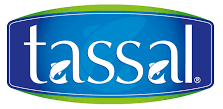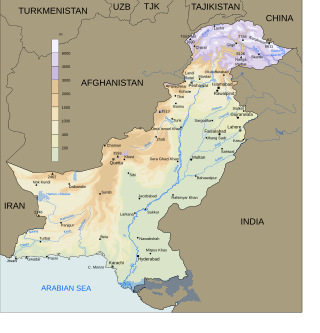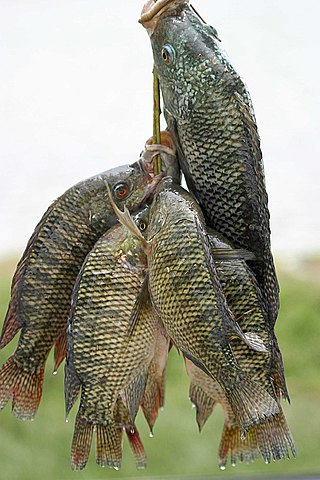
Aquaculture, also known as aquafarming, is the controlled cultivation ("farming") of aquatic organisms such as fish, crustaceans, mollusks, algae and other organisms of value such as aquatic plants. Aquaculture involves cultivating freshwater, brackish water and saltwater populations under controlled or semi-natural conditions, and can be contrasted with commercial fishing, which is the harvesting of wild fish. Aquaculture is also a practice used for restoring and rehabilitating marine and freshwater ecosystems. Mariculture, commonly known as marine farming, is aquaculture in seawater habitats and lagoons, as opposed to freshwater aquaculture. Pisciculture is a type of aquaculture that consists of fish farming to obtain fish products as food.

Mariculture, sometimes called marine farming or marine aquaculture, is a specialized branch of aquaculture involving the cultivation of marine organisms for food and other animal products, in enclosed sections of the open ocean, fish farms built on littoral waters, or in artificial tanks, ponds or raceways which are filled with seawater. An example of the latter is the farming of marine fish, including finfish and shellfish like prawns, or oysters and seaweed in saltwater ponds. Non-food products produced by mariculture include: fish meal, nutrient agar, jewellery, and cosmetics.

The Indian prawn is one of the major commercial prawn species of the world. It is found in the Indo-West Pacific from eastern and south-eastern Africa, through India, Malaysia and Indonesia to southern China and northern Australia. Adult shrimp grow to a length of about 22 cm (9 in) and live on the seabed to depths of about 90 m (300 ft). The early developmental stages take place in the sea before the larvae move into estuaries. They return to the sea as sub-adults.
Broodstock, or broodfish, are a group of mature individuals used in aquaculture for breeding purposes. Broodstock can be a population of animals maintained in captivity as a source of replacement for, or enhancement of, seed and fry numbers. These are generally kept in ponds or tanks in which environmental conditions such as photoperiod, temperature and pH are controlled. Such populations often undergo conditioning to ensure maximum fry output. Broodstock can also be sourced from wild populations where they are harvested and held in maturation tanks before their seed is collected for grow-out to market size or the juveniles returned to the sea to supplement natural populations. This method, however, is subject to environmental conditions and can be unreliable seasonally, or annually. Broodstock management can improve seed quality and number through enhanced gonadal development and fecundity.

Tassal is a Tasmanian-based Australian salmon farming company founded in 1986. It was listed on the Australian Securities Exchange (ASX) from 2003 until 2022. Tassal is the largest producer of Tasmanian grown Atlantic salmon, supplying salmon to both domestic and international markets. In November 2022, it was purchased by Cooke Seafood of Canada and delisted from the ASX.

A fish hatchery is a place for artificial breeding, hatching, and rearing through the early life stages of animals—finfish and shellfish in particular. Hatcheries produce larval and juvenile fish, shellfish, and crustaceans, primarily to support the aquaculture industry where they are transferred to on-growing systems, such as fish farms, to reach harvest size. Some species that are commonly raised in hatcheries include Pacific oysters, shrimp, Indian prawns, salmon, tilapia and scallops.
Oyster farming is an aquaculture practice in which oysters are bred and raised mainly for their pearls, shells and inner organ tissue, which is eaten. Oyster farming was practiced by the ancient Romans as early as the 1st century BC on the Italian peninsula and later in Britain for export to Rome. The French oyster industry has relied on aquacultured oysters since the late 18th century.

The southern bluefin tuna is a tuna of the family Scombridae found in open southern Hemisphere waters of all the world's oceans mainly between 30°S and 50°S, to nearly 60°S. At up to 2.5 metres and weighing up to 260 kilograms (570 lb), it is among the larger bony fishes.

Integrated multi-trophic aquaculture (IMTA) provides the byproducts, including waste, from one aquatic species as inputs for another. Farmers combine fed aquaculture with inorganic extractive and organic extractive aquaculture to create balanced systems for environment remediation (biomitigation), economic stability and social acceptability.
This page is a list of fishing topics.

As with other countries, the 200 nautical miles (370 km) exclusive economic zone (EEZ) off the coast of the United States gives its fishing industry special fishing rights. It covers 11.4 million square kilometres, which is the second largest zone in the world, exceeding the land area of the United States.

Aquaculture started to take off in New Zealand in the 1980s. It is dominated by mussels, oysters and salmon. In 2007, aquaculture generated about NZ$360 million in sales on an area of 7,700 hectares. $240 million was earned in exports.
Seafood in Australia comes from local and international commercial fisheries, aquaculture and recreational anglers. It is an economically important sector, and along with agriculture and forestry contributed $24,744 million to Australia's GDP in year 2007–2008, out of a total GDP of $1,084,146 million. Commercial fisheries in Commonwealth waters are managed by the Australian Fisheries Management Authority, while commercial and recreational fishing in state waters is managed by various state-level agencies.

Fishery and fishing industry plays a significant part in the national economy of Pakistan. With a coastline of about 1,120 km, Pakistan has enough fishery resources that remain to be developed. Most of the population of the coastal areas of Sindh and Balochistan depends on fisheries for livelihood. It is also a major source of export earning.

Scallop aquaculture is the commercial activity of cultivating (farming) scallops until they reach a marketable size and can be sold as a consumer product. Wild juvenile scallops, or spat, were collected for growing in Japan as early as 1934. The first attempts to fully cultivate scallops in farm environments were not recorded until the 1950s and 1960s. Traditionally, fishing for wild scallops has been the preferred practice, since farming can be expensive. However worldwide declines in wild scallop populations have resulted in the growth of aquaculture. Globally the scallop aquaculture industry is now well established, with a reported annual production totalling over 1,200,000 metric tonnes from about 12 species. China and Japan account for about 90% of the reported production.

South Africa has an emerging aquaculture. It consists mainly of culture of freshwater species such as crocodiles, trout, catfish, tilapia, and ornamental fish as well as marine species such as abalone, prawns, oysters, and mussels.

Offshore aquaculture, also known as open water aquaculture or open ocean aquaculture, is an emerging approach to mariculture where fish farms are positioned in deeper and less sheltered waters some distance away from the coast, where the cultivated fish stocks are exposed to more naturalistic living conditions with stronger ocean currents and more diverse nutrient flow. Existing "offshore" developments fall mainly into the category of exposed areas rather than fully offshore. As maritime classification society DNV GL has stated, development and knowledge-building are needed in several fields for the available deeper water opportunities to be realized.
Craig Foster is the CEO of Clean Seas, an ASX-listed Australian seafood company with interests in southern bluefin tuna and yellowtail kingfish farming. He was appointed to the position in 2012 after working in the salmon farming industry in Tasmania. There he managed research and development at the state's largest salmon hatchery and also worked as the Managing Director of fish feed producer, Gibsons Ltd. In 2001, he was working for Pivot, and assisting in the development of barramundi farms in the Northern Territory.

Aquaculture in the United Kingdom is dominated by salmon farming, then by mussel production with trout being the third most important enterprise. Aquaculture in the United Kingdom represents a significant business for the UK, producing over 200,000 tonnes of fish whilst earning over £700 million in 2012 (€793 million).
Fish farming is a major economic contributor to South Australia's seafood sector. The most valuable species is the Southern bluefin tuna, which is caught in the wild then transferred into sea cages in southern Spencer Gulf where they are fed locally caught sardines. The second most valuable species is the Yellowtail kingfish, which is farmed near Port Lincoln and Arno Bay. A tourist venture called Oceanic Victor located in Encounter Bay allows paying customers the opportunity to swim in a sea cage with the Southern bluefin tuna and handfeed the fish. Prominent companies in the fish farming sector in South Australia include Clean Seas and Tony's Tuna International.
















